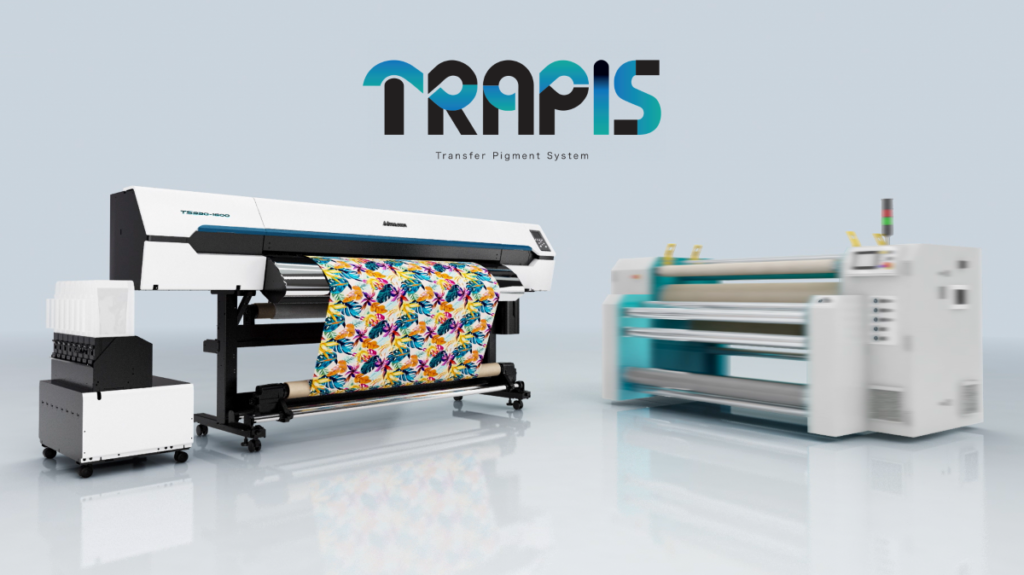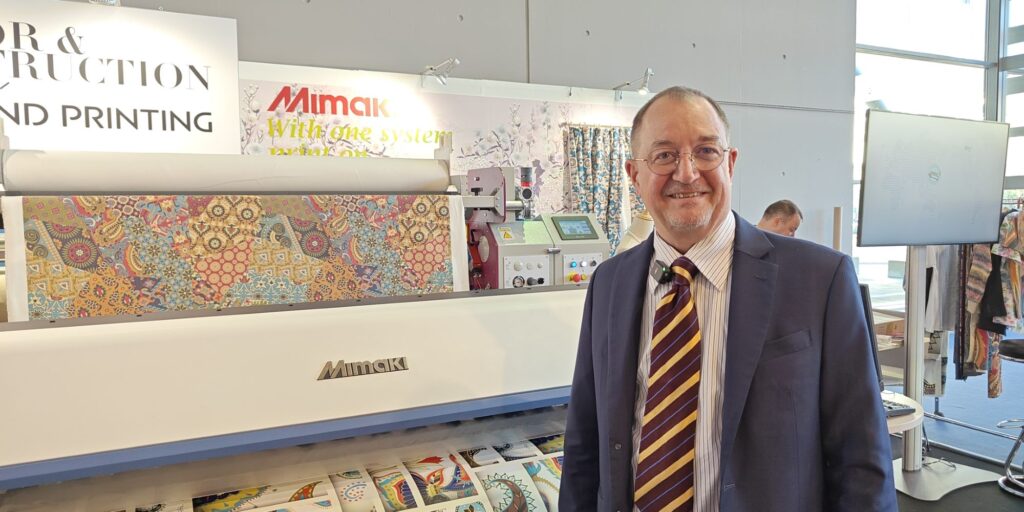At Heimtextil 2025 in Frankfurt, Mimaki showcased its latest breakthrough in textile printing technology—TRAPIS (Transfer Pigment System). This innovative solution is set to revolutionize non-synthetic textile printing by offering an eco-friendly, waterless alternative that eliminates traditional dyeing processes. In an exclusive conversation, Mr. Rodd Harrison, General Manager, Global Brand Engagement at Mimaki, shared insights on TRAPIS, its market impact, and its potential for transforming the global textile industry.

Introducing TRAPIS: The Future of Sustainable Textile Printing
Mimaki’s TRAPIS is a first-of-its-kind transfer pigment printing system that enables printing on non-synthetic textiles like cotton, linen, silk, and wool, as well as blends and synthetic fabrics such as lycra and spandex. Unlike traditional dye sublimation, which requires pre-coating and post-processing, TRAPIS eliminates these steps, reducing water and energy consumption dramatically.
The system works with Texcol paper from Coldenhove, where the bonding agent is embedded in the paper itself. The printing process is simple: print on the paper, transfer to fabric using a calendaring device, and the print is ready—no washing, steaming, or drying required. This two-step process simplifies production and opens up a world of applications, from apparel and upholstery to curtains, roller blinds, and throw cushions.
Sustainability at the Core
The textile industry is a major contributor to global water pollution and CO₂ emissions, with an impact comparable to the aviation sector. TRAPIS offers an environmentally sustainable alternative by removing water-intensive steps from the production cycle.
“We believe textiles need a revolution. Sustainability cannot be just a conversation—it requires tangible solutions. TRAPIS allows brands to reduce their environmental footprint while maintaining quality and flexibility,” said Mr. Harrison.
Mimaki views this technology as a major step forward in sustainable printing, akin to where dye sublimation was 20 years ago. The industry now has an opportunity to shift upstream supply chains towards greener solutions, empowering brands to adopt genuinely sustainable practices rather than just making sustainability claims.

Market Response and Adoption
Mimaki first introduced TRAPIS at major international events, including ITMA in Milan, FESPA, and Drupa in 2024, before launching a global roadshow in late 2024. The response has been overwhelmingly positive, with industry players recognizing its potential to streamline production, reduce costs, and expand textile application possibilities.
With TRAPIS, users benefit from:
- Faster production cycles, reducing turnaround from weeks to days
- A single ink, paper, and profile system, allowing seamless adaptation across multiple fabric types
- Lower skill and maintenance requirements, making it ideal for both large-scale manufacturers and small businesses
“The market response has exceeded our expectations,” said Mr. Harrison. “Customers appreciate the ability to print high-quality textiles in a cost-effective, sustainable way. This is the future of textile printing.”
Who Should Invest in TRAPIS?
The versatility of TRAPIS makes it suitable for both large-scale manufacturers and small businesses. Large manufacturers can integrate TRAPIS alongside existing dye sublimation processes to increase efficiency, while smaller businesses can leverage it to expand product lines with high-margin offerings.
“In a world where dye sublimation has become highly commoditized, TRAPIS allows businesses to differentiate themselves through new product categories. It provides the flexibility to print on a variety of textiles without coating requirements, reducing the barriers to entry for smaller enterprises,” Mr. Harrison explained.
While TRAPIS is initially targeting home textiles, upholstery, and interior decor applications, Mimaki foresees a gradual adoption in the fashion industry, particularly as brands seek alternatives to polyester-based printing.
The Indian Market and Future Prospects
India is a key market for Mimaki, and TRAPIS is already gaining traction among Indian manufacturers. While Mr. Harrison could not disclose details, he confirmed that a textile solutions provider in India has already begun working with the technology.
He further emphasized that TRAPIS aligns with India’s growing demand for sustainable solutions, particularly in home textiles and fashion segments. “India is a natural fit for TRAPIS because of its diverse textile heritage and increasing focus on eco-friendly production,” he said.
Mimaki plans to host open house events and industry engagements in India, allowing manufacturers to explore how TRAPIS can enhance their production capabilities while reducing environmental impact.
The Road Ahead for Mimaki and TRAPIS
Looking ahead, Mimaki has a full lineup of trade shows, conferences, and product launches planned for 2025. In addition to Heimtextil, the company will showcase TRAPIS at multiple international events, engaging with brands and manufacturers to accelerate its adoption.
“We’re excited about bringing real sustainability to the textile industry. This is just the beginning—more innovations will follow as we continue to lead the transition to eco-friendly printing technologies,” said Mr. Harrison.
Mimaki’s TRAPIS is not just another textile printing solution—it is a game-changer in sustainable manufacturing. By eliminating water-intensive processes, simplifying production, and expanding fabric possibilities, TRAPIS is paving the way for a greener, more efficient future in textile printing.
With strong market interest, strategic industry partnerships, and a commitment to sustainability, Mimaki is set to redefine the future of digital textile printing—one innovation at a time.
